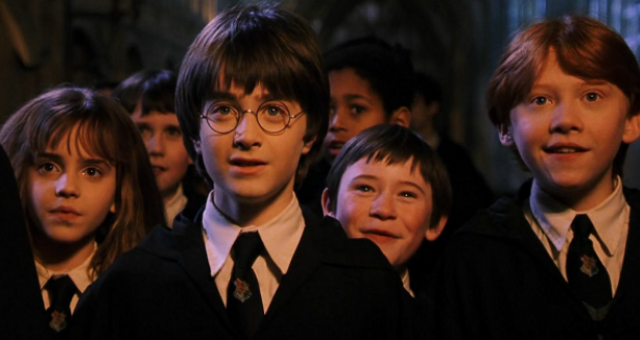
Harry Potter: The War of Race
Although I don’t like to admit it, I am a huge Harry Potter geek. Maybe this is because I read all of the books (twice) when I was in grade school and am now growing self-conscious of being associated with a series created for thirteen year olds, or maybe it’s because I’m embarrassed of the excessiveness of my obsession (I went as Harry Potter for Halloween three years in a row). Despite my embarrassment, I’ll admit it now: I know everything there is to know about the Harry Potter series — or at least so I thought.
Having not touched a Harry Potter book in over five years and only catching glimpses of the movies when they air on ABC Family, I am surprised that I am still able to retain so much information about the series. But, as it turns out, I still know a lot. I know that the author J.K Rowling came up with the idea for the series while waiting for a train, but don’t remember how the hell I learned that. I know all of the major characters by heart and can quote nearly every scene in the movies. I know what actors play the major roles and how they differed from my expectations from the characters in the novels. I know the minor characters and their specific roles in the story. I know the plot so well that I can pick out deficiencies between the movies and the novels. I know the pronunciation of most of the spells and enchantments and their purposes. I know how the point system works in a quidditch match.

Now, I gained all of this knowledge while in my Harry-Potter-Geek phase, as I like to refer to it as. I was simply a kid living vicariously through the magical world that J.K Rowling created for me and enjoying every second of it. I had a notion of the elements of good and evil that are relevant in the plot, but did not concern myself with anything more complex than that. Why would I? I was young and oblivious to the cultural and societal issues happening around me. So, at the time, I had no reason to believe that there was much more to the Harry Potter series other than the fact that Harry was a bad-ass teenager with magical abilities who ends up becoming a hero by saving the world from the evil that is seeking to destroy it. What I have come to understand since then, however, is that pop culture can provide accurate depictions of the reality of our society, and that it can do this in subtle ways that don’t necessarily jump out on the pages of the story.
The Harry Potter series is a war between the good and the evil — we know this. But what people fail to grasp is that it is really a war between the white and the black; a war of race. This war is most clearly represented by the struggle between light and darkness, where light and the color white represents the good, while darkness and the color black represents the evil. I’m not saying that Rowling is guilty of racism. I am simply saying that the world that she creates throughout the series is filled with the same racial prejudice of society.
In the series, race is not mentioned at all — nearly every character is white! However, race is not always expressed through skin color. In Harry Potter, there are certain elements of darkness that are associated with evil characters that suggest racial prejudice towards people of color.
Lord Voldemort is the source of all evil and is referred to as “The Dark Lord.” He is always dressed in a black cloak and is known for the practice of “dark magic,” which is really just another term for evil magic. His followers, the Death Eaters, are also dressed in black and like their leader, are notorious for the use of this dark magic. When they disapparate, which is really just the wizard term for teleportation, they disappear in a cloud of black smoke. Additionally, they all have a black mark consisting of a skull and serpent engraved on their forearms called the “dark mark.” This mark was feared throughout the wizarding world as it represents evil and was often associated with murder. If you lived in the wizarding world and came home to this mark projected in the sky above your house, you could only assume the worst. It is interesting how the dark mark on the arms of the Death Eaters is faded during the first three novels and then regains its dark color in The Goblet of Fire. The darkness of the mark seems to increase as Voldemort regains his powers, suggesting that as evil increases, darkness becomes more prevalent.

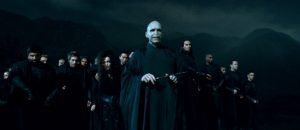
In contrast, Albus Dumbledore is the most powerful wizard on the “good” side of the war and represents a source of light that combats darkness. Unlike the evil characters who are typically shown wearing all black, he is often depicted wearing light-colored gowns, complimenting his long silver hair and beard. His Phoenix, Fawkes, gives him the ability to disappear in a burst of flames and represents fire and light. Throughout the series, Dumbledore mentors Harry, shaping him into a wizard that is able to lead the good against the darkness. In the last novel, Harry is viewed as the last sign of hope for the Wizarding World, as he is the only one who can face and defeat Voldemort. Similarly to how evil is associated with darkness, this sense of hope is associated with light. Hope is a source of light in times of darkness, and light symbolizes the good. Rowling is shaping her reader’s attitudes towards light and darkness through these associations, and consequently, she is shaping her readers attitudes towards race.
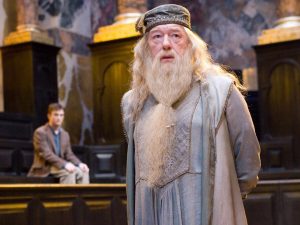
But it doesn’t stop there. The Black Family is a notorious supporter of Voldemort and dark magic. Rowling specifically chose their family name to be “Black,” which immediately associates them with darkness and evil. Bellatrix Lestrange, cousin of Sirius Black, is one of the most feared Death Eaters in the series. In addition to being a part of the Black family, she is also depicted as dirty and somewhat trashy, especially in the scene where she escapes from Azkaban prison in The Order of The Phoenix. The way she is characterized here highlights her imperfections: the dirt on her face and body has an evil connotation — it is tainting her normally white complexion. This sense of dirtiness can also be seen in Sirius Black, the Godfather of Harry, during the third novel when he is still believed to be a murderer and blamed for the death of Harry’s parents. However, this dirt seems to fade as Harry learns the truth about his story and begins to see the good inside him. As he becomes more clean and more white, readers are able to view him as a member of the good side like Harry does.
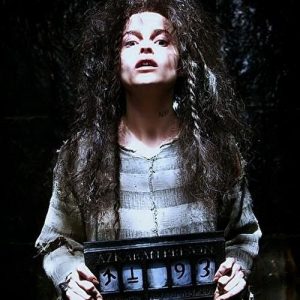
The dementors of Azkaban epitomize the association between evil and darkness in the series. In the third novel, Professor Lupin describes them: “Dementors are among the foulest creatures that walk this earth. They infest the darkest, filthiest places, they glory in decay and despair, they drain peace, hope, and happiness out of the air around them… Get too near a Dementor and every good feeling, every happy memory will be sucked out of you. If it can, the Dementor will feed on you long enough to reduce you to something like itself… soulless and evil. You will be left with nothing but the worst experiences of your life” (The Prisoner of Azkaban, 16.42). The only way to counter an attack from a dementor is to conjure a patronus charm, which is really just a shield of white mist that drives them away. So, a dirty, soulless, evil creature is able to be beaten back by the whiteness and brightness of a charm — shocker!
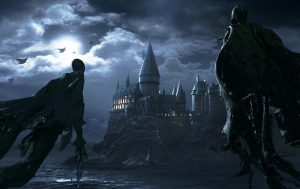
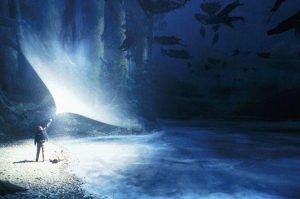
In addition to the relationship between light and darkness, Rowling creates another racial separation within the Wizarding World through the purity or impurity of blood. A “Pureblood” is a witch or wizard that has two magical parents. In the series, purebloods replicate the white elitist group that is prevalent in our society. The Malfoy Family is a good example of this as they are wealthy, entitled, and narcissistic. Voldemort’s followers are almost entirely made up of Purebloods. In this sense, they are pure, clean, and white, which are the characteristics of the good in this racial war. However, in reality the evil that they believe in pollutes this with darkness. On the other hand, a “Mudblood” is a witch or wizard with no magical parents, and are viewed as minorities and a disgrace to the wizarding world by Purebloods as a result of the “dirtiness” of their blood. Hermione Granger is a good example of this. Despite the impurity of her blood, she proves to be one of the most talented and intelligent witches of her age, illustrating how race often attaches certain assumptions with biological factors that really have no intrinsic meaning.
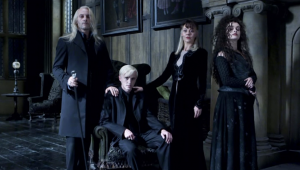
Furthermore, magical creatures such as house-elves fall below Mudbloods in this racial hierarchy that Rowling has created. In The Chamber of Secrets, we are first introduced to the house-elf Dobby, who is the property of the Malfoy Family and is meant to serve them for the duration of his life. The ownership of house-elves and the fact that they considered “property” of witches and wizards can be easily compared to the slavery that was once prevalent in the United States. Despite his magical abilities, Dobby is dressed in a single rag and is covered in dirt. The Malfoy Family has little regard for his well-being and treat him in a harsh way similar to how American slave owners treated their slaves. Alyssa Hunziker of the University of Florida points out that “despite the fact that [house-elves] possess magic that is even more powerful than wizards’, they do not question the human-run Ministry of Magic’s decree that ‘no non-human creature is permitted to carry or use as wand’ (Goblet of Fire 132)” (Hunziker 54). She goes on to explain how house-elves are denied the same rights of magical humans as a result of their biological differences. When first reading the series, I did not make this connection. However, Rowling intentionally portrays house-elves and their relationship with magical humans in a way that can be easily compared to African-American slaves, illustrating how race and racial prejudice can be expressed in ways other than the complexion of skin.
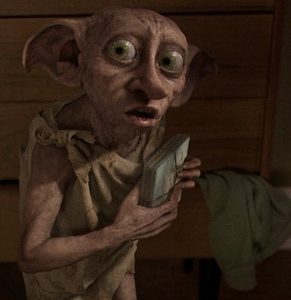
In a fictional fantasy that involves flying around on broomsticks and spouting magical powers out of a foot long piece of wood, Rowling is able to confirm racial prejudices and educate her readers about how society views race in general. When first introduced to the series, we are able to see a war between good and evil, light and darkness, pure and impure. But what we fail to realize is Rowling’s attempt to express society’s seemingly automatic associations of color and race: black is evil, white is good. Imagine that Voldemort and his Death Eaters were depicted wearing all white instead of black, and that they used “light magic” instead of dark. This would not make sense to us because it differs from the racial connotations that society has created around the colors black and white. We also fail to realize how Rowling has flipped these racial connotations to express the problems with the racial hierarchy in our society. Jordana Hall states “The carnivalesque and grotesque in Harry Potter illustrates an appeal to social transformation through the power of laughter and the reversal of the dominant order of race and racial difference” (Hall). Rowling associates darkness and dirtiness (grotesque attributes) with purity and whiteness to illustrate the content and desire for power of white elitists just as she associates laughter, love, and light (carnivalesque attributes) with impurity in order to promote equality and the dispersion of white domination.
Race is a lived fiction. While the concept may seem to be centered around skin color, in reality it is about the seemingly necessary connotations that are naturally attached to skin color and social status. At first glance, it is difficult to spot race in the all white wizarding world of Harry Potter. However, the way Rowling depicts her characters sheds light on these assumptions and associations, allowing her to create a powerful story behind the one of the boy who lived in the cupboard under the stairs — a story of racial prejudice and social transformation.
References:
Hall, Jordana. “Embracing the Abject Other: The Carnival Imagery of Harry Potter.” Springer: Children’s Literature in Education, 18 Dec. 2010.
Hunziker, Alyssa. “Embodiment of Collective Exclusion: Transcending the Borders of Social Segregation in Harry Potter.” DisClosure: A Journal of Social Theory, University of Florida, Apr. 2013.
Klosterman, Chuck. “Death by Harry Potter.” Esquire 2007.
Rowling, J.K. Harry Potter and the Philosopher’s Stone. London: Bloomsbury Publishing, 1997. Print
Rowling, J.K. Harry Potter and the Chamber of Secrets. London: Bloomsbury Publishing, 1998. Print
Rowling, J.K. Harry Potter and the Prisoner of Azkaban. London: Bloomsbury Publishing, 1999. Print
Rowling, J.K. Harry Potter and the Goblet of Fire. London: Bloomsbury Publishing, 2000. Print
Rowling, J.K. Harry Potter and the Order of the Phoenix. London: Bloomsbury Publishing, 2003. Print
Rowling, J.K. Harry Potter and the Half-Blood Prince. London: Bloomsbury Publishing, 2005. Print
Rowling, J.K. Harry Potter and the Deathly Hallows. London: Bloomsbury Publishing, 2007. Print